
Uppland Runic Inscription 1144 or U 1144 is the Rundata catalog designation of a Viking Age memorial runestone in a churchyard that is located five kilometers southwest of Tierp, Uppsala County, Sweden, which was in the historic province of Uppland.

Uppland Runic Inscription 1144 or U 1144 is the Rundata catalog designation of a Viking Age memorial runestone in a churchyard that is located five kilometers southwest of Tierp, Uppsala County, Sweden, which was in the historic province of Uppland.
The runic inscription consists of runic text within bands that are around an unusual image of a Christian cross surrounded by stylized serpents and two lambs. It has been suggested that the runestone's iconography of an adoring lamb on each side of the cross may have been based on similar images seen during pilgrimages to Rome or the Holy Land. [1] The stone is composed of granite and is 1.8 meters in height with the upper right portion missing. The inscription is classified as being carved in runestone style Pr3, which is also known as Urnes style. This runestone style is characterized by slim and stylized animals that are interwoven into tight patterns. The animal heads are typically seen in profile with slender almond-shaped eyes and upwardly curled appendages on the noses and the necks.
The runic text on runestone U 1144 states that the stone is a memorial raised by five brothers in memory of their father Geiri, and, consistent with the iconography, includes a prayer for his soul. The inscription is signed by two runemasters with the normalized names of Hæriarr and Åsmund Kåresson. [2] Åsmund was a runemaster active in the Uppland region in the first half of the eleventh century and signed about twenty runic inscriptions, with another thirty stones attributed to him. Other surviving runestones that are signed by Åsmund include U 301 in Skånela, the now-lost U 346 in Frösunda, U 356 in Ängby, the now-lost U 368 in Helgåby, U 824 in Holm, U 847 in Västeråker, U 859 in Måsta, U 871 in Ölsta, U 884 in Ingla, U 932 at Uppsala Cathedral, U 956 in Vedyxa, U 969 in Bolsta, the now-lost U 986 in Kungsgården, U 998 in Skällerö, U 1142 in Åbyggeby, U 1149 in Fleräng, U Fv1986;84 in Bo gård, U Fv1988;241 in Rosersberg, Gs 11 in Järvsta, Gs 12 in Lund, and Gs 13 in Söderby. The signature of Hæriarr, however, is not on any other surviving runestone. When writing runic text, it was common to only carve a single rune for two consecutive letters, even when the letters were at the end of one word and the beginning of a second word. [3] When the text is shown as Latin characters, the transliterated runes are doubled and separate words are shown. In the runemaster's signature, osmuntritsi, an additional r-rune, is added in the transliteration to form the words osmuntr| |ritsi ("Ásmundr carved"). Åsmund signed his name using the same runes on two other inscriptions, U 824 and U 1142.
| Wikimedia Commons has media related to Upplands runinskrifter 1144 . |
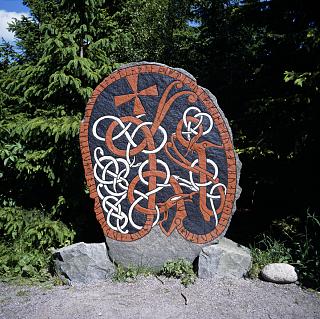
U 871 is a 12th-century runestone in the Rundata catalog, originally from Ölsta, a village in the county of Uppland in Sweden. It is now on display at Skansen, near Stockholm.
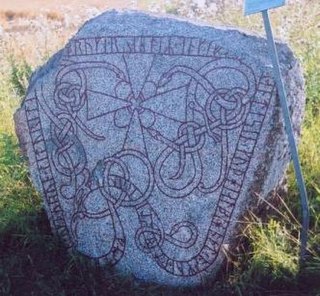
Åsmund Kåresson was a Viking Age runemaster who flourished during the first half of the 11th century in Uppland and Gästrikland, Sweden. The early Urnes style is represented in his art.

The Granby Runestone, designated as U 337 under the Rundata catalog, is one of the longest Viking Age runic inscriptions located in Uppland, Sweden.

The Lingsberg Runestones are two 11th-century runestones, listed as U 240 and U 241 in the Rundata catalog, and one fragment, U 242, that are engraved in Old Norse using the younger futhark. They are at the Lingsberg farm about 2 kilometres (1.2 mi) east of Vallentuna, which is about 24 kilometres (15 mi) north of the center of Stockholm, Stockholm County, Sweden, which was part of the former province of Uppland.

The Greece runestones are about 30 runestones containing information related to voyages made by Norsemen to the Byzantine Empire. They were made during the Viking Age until about 1100 and were engraved in the Old Norse language with Scandinavian runes. All the stones have been found in modern-day Sweden, the majority in Uppland and Södermanland. Most were inscribed in memory of members of the Varangian Guard who never returned home, but a few inscriptions mention men who returned with wealth, and a boulder in Ed was engraved on the orders of a former officer of the Guard.
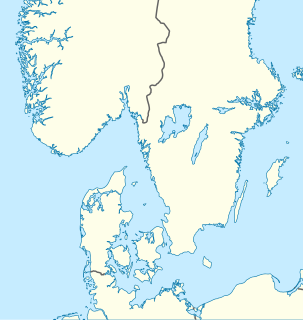
The England runestones are a group of about 30 runestones in Northern Europe which refer to Viking Age voyages to England. They constitute one of the largest groups of runestones that mention voyages to other countries, and they are comparable in number only to the approximately 30 Greece Runestones and the 26 Ingvar Runestones, of which the latter refer to a Viking expedition near the Caspian Sea. They were engraved in Old Norse with the Younger Futhark.

The Varangian Runestones are runestones in Scandinavia that mention voyages to the East (Austr) or the Eastern route (Austrvegr), or to more specific eastern locations such as Garðaríki.
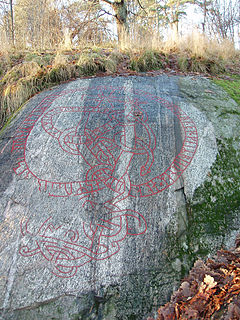
Runic inscription U Fv1986;84 is the Rundata catalog number for a Viking Age memorial that is located at Bo gård on the island of Lidingö in Uppland, Sweden.

Uppland Runic Inscription 1034 or U 1034 is the Rundata catalog number for a runic inscription on a runestone located at the Tensta Church, which is three kilometers northwest of Vattholma, Uppsala County, Sweden, and in the historic province of Uppland, that was carved in the late 11th or early 12th century. While the tradition of carving inscriptions into boulders began in the 4th century and lasted into the 12th century, most runestones date from the late Viking Age.

Uppland Runic Inscription Fv1946;258 or U Fv1946;258 is the Rundata catalog designation for a Viking Age memorial runic inscription to two fathers that is located in Fällbro, which is about 5 kilometers northwest of Täby, Stockholm County, Sweden, which is in the historic province of Uppland.

This runic inscription, designated as U Fv1948;168 in the Rundata catalog, is on a Viking Age memorial runestone to two sons that is located in Alsike, Uppsala County, Sweden, which is in the historic province of Uppland.

This runic inscription, designated as U Fv1976;104 in the Rundata catalog, is on a Viking Age memorial runestone that is located at the Uppsala Cathedral, Uppland, Sweden.
The Lilla Vilunda runestones are three Viking Age memorial runestones that were erected by members of the same family and which are located at Lilla Vilunda in Upplands Väsby, Stockholm County, Sweden, and in the historic province of Uppland.

The Björklinge runestones are five Viking Age memorial runestones designated in the Rundata catalog as U 1045, U 1046, U 1047, U 1048, and U 1050 that are located at the church in Björklinge, Uppsala County, Sweden, which is in the historic province of Uppland. In addition, there is a small fragment of a runestone with a partial runic text i * lit * rita * meaning "had erected" that has been given the catalog number U 1049.
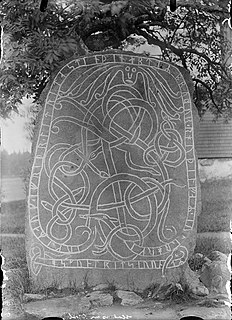
Uppland Runic Inscription 824 is the Rundata catalog number for a Viking Age memorial runestone located at Holms, which is about eight kilometers east of Örsundsbro, Uppsala County, Sweden, and in the historic province of Uppland. The inscription features a facial mask and a bind rune in the text.

Uppland Runic Inscription 181 or U 181 is the Rundata catalog number for a Viking Age memorial runestone located at Össeby-Garn, which is about one kilometer east of Karby, Uppsala County, Sweden.
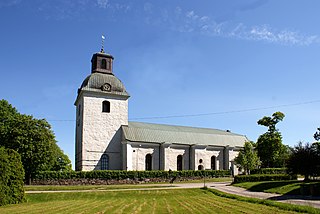
The Ovansjö Runestones are two Viking Age memorial runestones and fragments of a third that were found in a church in Ovansjö, which is east of Kungsgården, Gävleborg County, Sweden, which was in the historic province of Gästrikland.

Uppland Runic Inscription Fv1953;263 or U Fv1953;263 is the Rundata catalog listing for a Viking Age memorial runestone that was discovered at Helenelund, which is in Sollentuna, Stockholm County, Sweden, which was in the historic province of Uppland.

The Vidbo Runestones are two Viking Age memorial runestones that are located in the churchyard of the Vidbo church, which is about ten kilometers east of Knivsta, Uppsala County, Sweden, in the historic province of Uppland.

The Bolsta Runestones are two Viking Age memorial runestones and two fragments of a third that are located in Bolsta, which is on the east edge of Uppsala, Uppsala County, Sweden, and in the historic province of Uppland. One runestone is signed by the runemaster with the normalized name of Åsmund Kåresson and the other by the runemaster named Öpir.